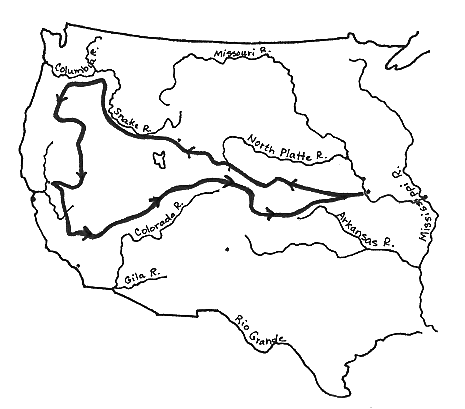| ||||
|
| ||||
|
JOHN
C. FREMONT
 Lived:
1813-1890
Lived:
1813-1890
Explored California in: 1843-1847
Exploring for: United States
Explored: by land throughout California
Interest in California was growing
within the
EARLY HISTORY
John Charles Frémont was born
in 1813 in Savannah,
His first assignment took him on a two-year trip into the wilderness of the upper Mississippi River, drawing maps and studying the plants and animals. In Washington, D.C. to report on his trip, Frémont met Jessie Benton, the daughter of Senator Thomas Hart Benton. Jessie and John were married in 1841.
BACKGROUND
Senator Benton and other congressmen wanted to encourage Americans to move west. At that time, the only maps of the west were crude and not very accurate. In 1842 the U.S. Congress decided to send an expedition to map the route west from Mississippi to South Pass in the Rocky Mountains. Frémont was chosen for this task.
FREMONT’S JOURNEY
Frémont hired hunters, mapmakers, and camp hands. He also hired Christopher “Kit” Carson, an experienced scout, as a guide. The expedition was successful, returning with more accurate maps of the route.
In 1843 Frémont went west again, this time to map the rest of the trail to Oregon. Again, Kit Carson was with him. They followed the trail to Fort Vancouver on the Columbia River, then turned south and made their way into California from Nevada. The pass they used through the mountains is now called Kit Carson Pass. They were caught by snowstorms in the Sierra Nevada, but pushed on into the Sacramento Valley and to Sutter’s Fort.
After a visit to Washington, D.C. to present the report of his journey, Frémont was on his way back to California, this time with a group of 62 armed men. Their orders were to survey parts of the Sierra Nevada, and to fight the Mexicans if war broke out in California. On this trip Frémont named the Humboldt River in Nevada. He made another winter crossing of the Sierra to Sutter’s Fort, and then went on to Monterey where he met with Thomas Larkin, the American consul.
After that meeting Frémont was
met by Mexican forces under General José Castro, who ordered him to leave.
In a defiant move, Frémont raised the
On May 8, 1846, Lt. Archibald H. Gillespie arrived on horseback with a message for Frémont from Washington, D.C. No one knows what that message said, but after reading it, Frémont headed south again into California and camped near Sonoma.
Frémont was soon taking part in events leading to the American conquest of California. Though he did not participate in the 1846 Bear Flag Revolt, he was no doubt a leading force behind it.
When American ships raised the American flag at Monterey a few weeks later, Frémont was put in command of a battalion. He led this battalion to southern California, where he accepted the surrender of Mexican General Andrés Pico at Cahuenga on January 13, 1847, ending the Mexican War in California.
WHAT HE ACCOMPLISHED
For his work in retracing the trails opened by other explorers and mapping them accurately, John Charles Frémont was given the nickname of “The Pathfinder.” With California now belonging to the United States, many more settlers were making the trip west. Frémont’s maps and books were a help to those pioneers.
Frémont wrote several books about his journeys. Jessie, his wife, was a good writer and helped to make the books interesting. Report of the Exploring Expedition to Oregon and North California told of his 1843 trip. Geographical Memoir upon Upper California was about his 1845-46 expedition.
LATER YEARS
In 1847 Frémont purchased Rancho Mariposas (in the Sierra above the San Joaquin Valley). He and Jessie went there to live. When gold was discovered on his property, Frémont became a wealthy man.
Frémont led two more expeditions west in the next few years, neither of them very successful. In 1848 he was caught in the Rockies in winter and eleven of the men with him died. In 1853 he tried to find a railroad route south of the Rockies, but failed.
California became the 31st state in 1850, and John Frémont was elected as a senator to represent the new state in Washington, D.C. In 1856 he was a candidate for president on the new antislavery Republican Party ticket, but was defeated by James Buchanan.
When the Civil War began, Frémont went back to the U.S. Army, this time with the rank of major general. After the Civil War, unwise business dealings brought about the loss of Frémont’s fortune and his rancho lands.
He went to Arizona where he served as governor of the Territory from 1878 to 1883. He then lived quietly with Jessie in Los Angeles and later in New York City. Jessie supported them by writing newspaper articles. Frémont was 77 years old when he died in 1890.